We wanted to get something to help Oliver with his photography at Cloggeroo last week, something that would clamp around the Moto G mobile phone he was using to shoot the photos, that would allow him both extra reach and a way of steadying the phone.
We went up to Best Buy the morning of Cloggeroo to see what we could find; I remembered there being a wide array of phone-mounts-for-tripods; alas there was nothing in evidence, and the staff disclaimed any knowledge of such things ever having existed.
Just before we headed out, empty-handed, I noticed a kit labelled Quik Pod by Digipower hanging in the camera accessories rack; it was exactly what we needed. Inside the carrying case was a telescoping monopod and a mobile phone clamp that screwed into it. It was $34, which seemed dear, but it was all they had, so we purchased one.
Here’s what it looks like:
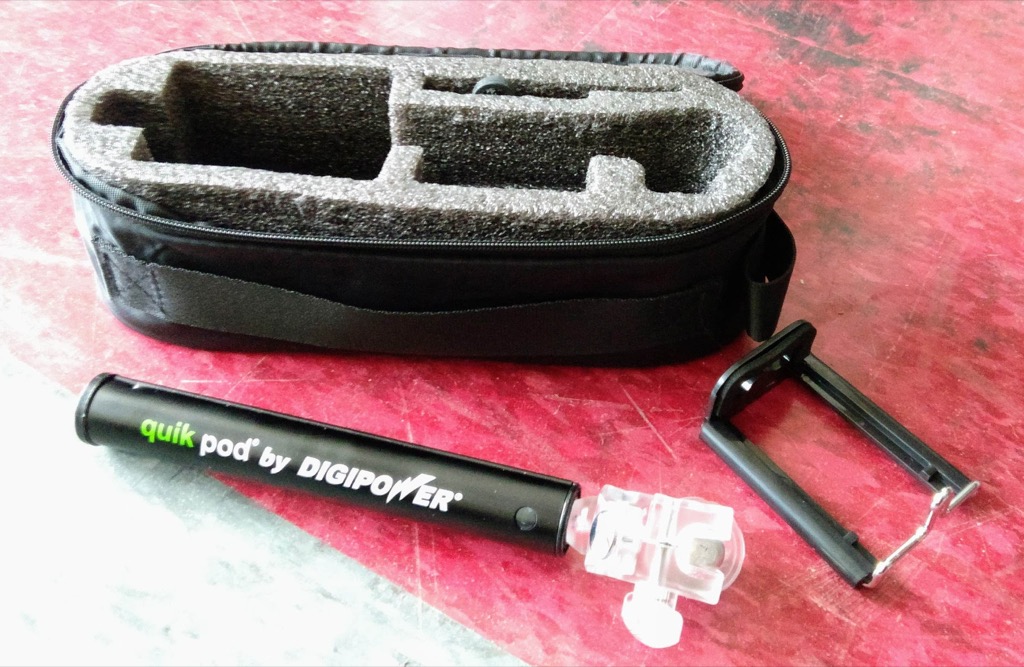
And here’s an annotated sketch illustrating how it all fits together:

The Quik Pod performed well at Cloggeroo: Oliver used it as a monopod, as a selfie-stick, and as an extension to allow better photos of the crowds. It was a good investment, and I’m sure we’ll make more use of it in the future.
It took more than two months from start to finish, but the Coles Building in Queens Square has a new set of stairs.
Demolition on the old concrete stairs, which had been patched beyond their ability to be patched any longer, started on June 7, 2017; through July and into August, MacLean Construction removed the rubble, set forms, poured concrete for the sides, let this set, set forms, poured concrete for the stairs, let this set, and, finally, put in place brand new rails on August 11, 2017.
The restored entrance, which affords access to the temporary home of the Legislative Assembly of PEI, opened earlier this week.
MacLean did great, careful work, and I’m certain that the new stairs will outlive it and me.
Because I walk by the Coles Building at least twice a day–it’s on my way to and from the office–I had a front-row seat to all of this, and every time there was a new development I snapped a photo.
Here’s a photographic journey through the process.

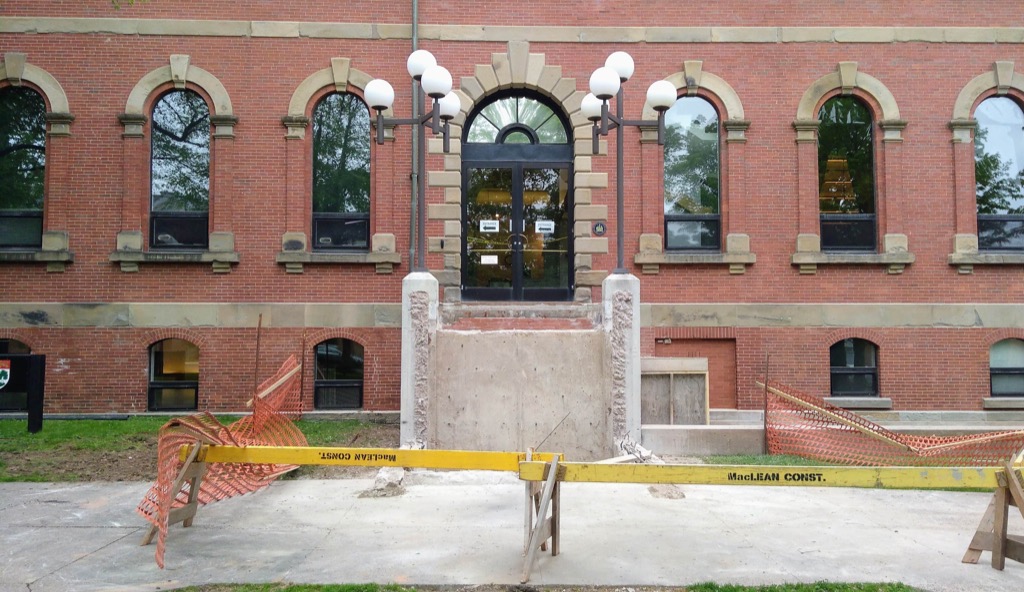
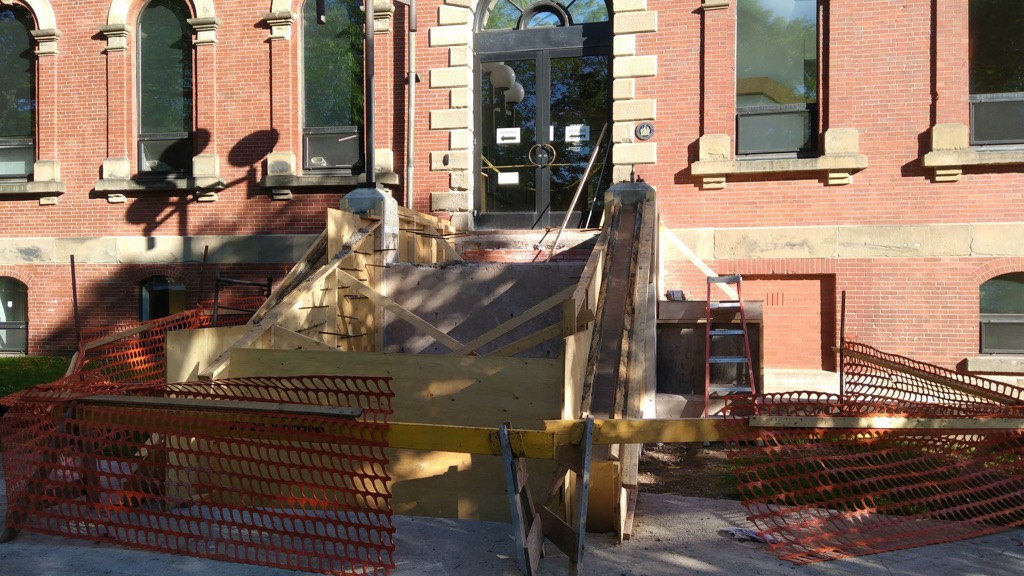
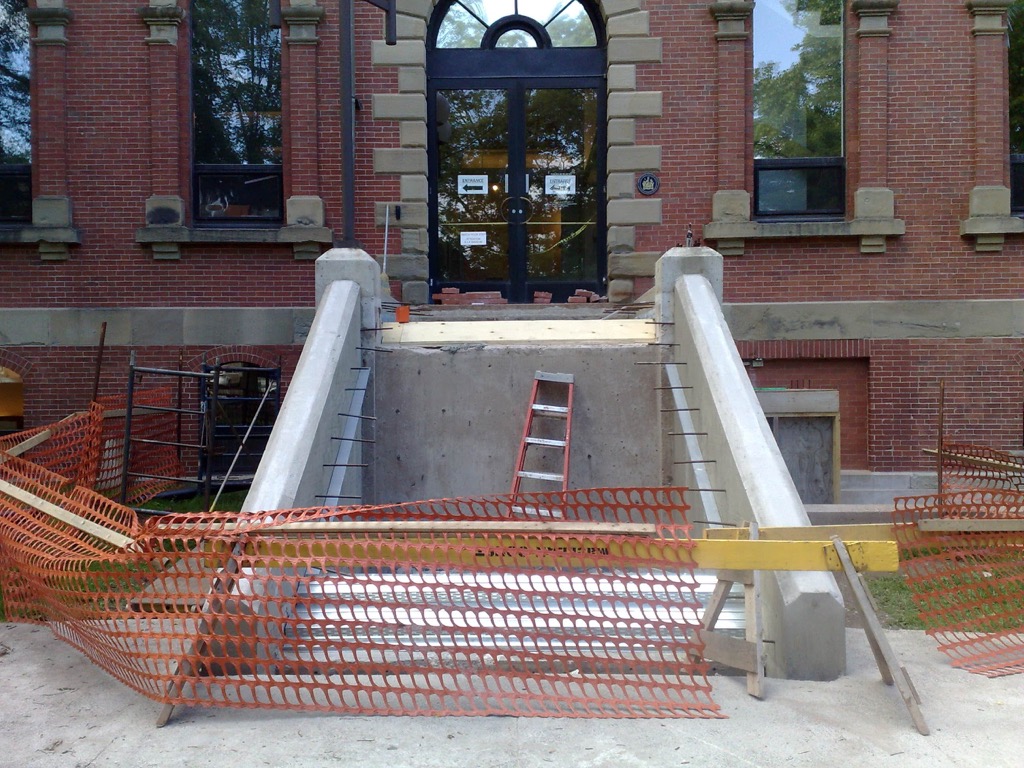

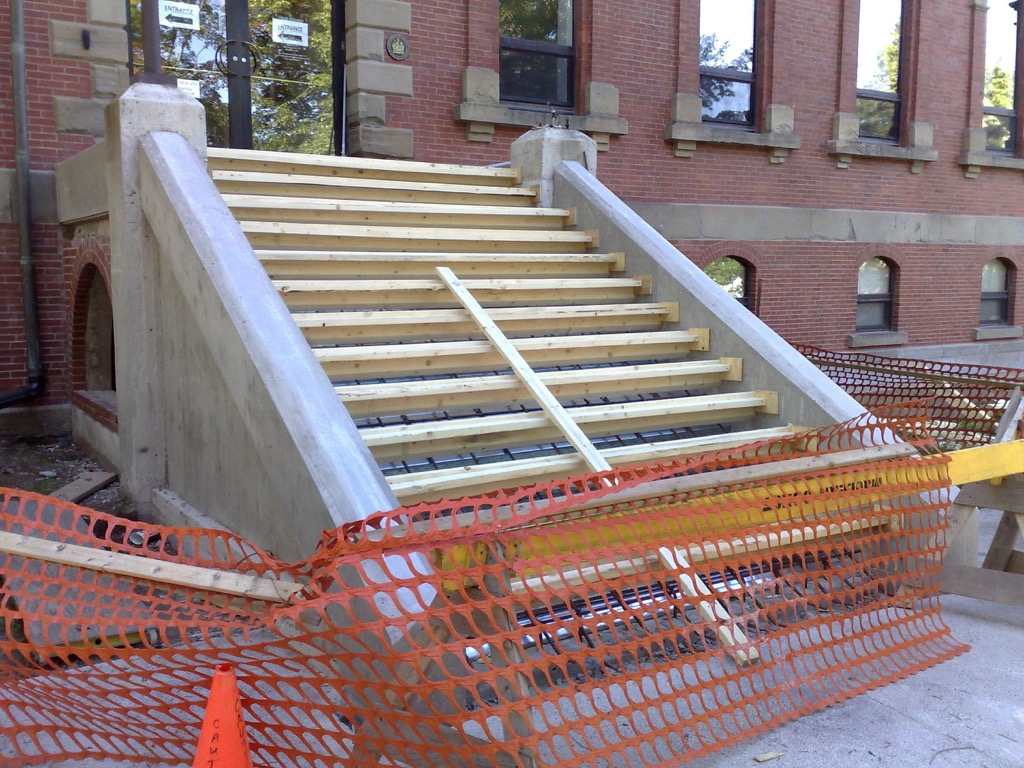
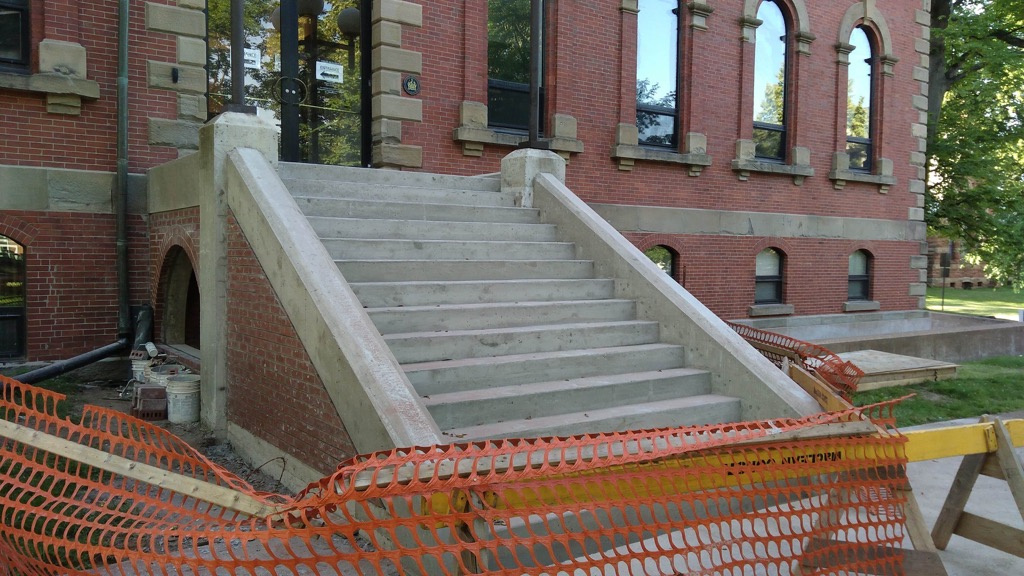
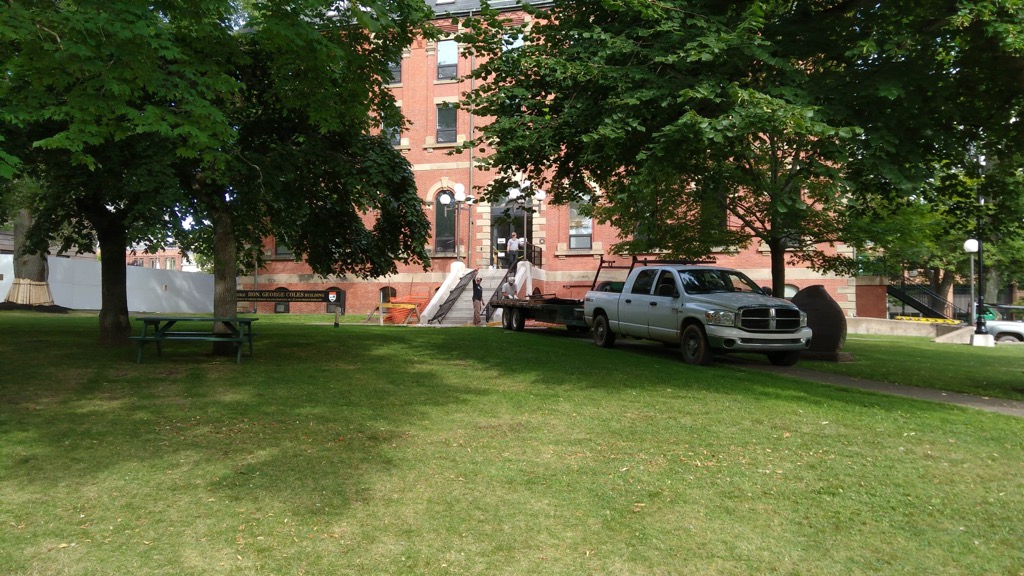
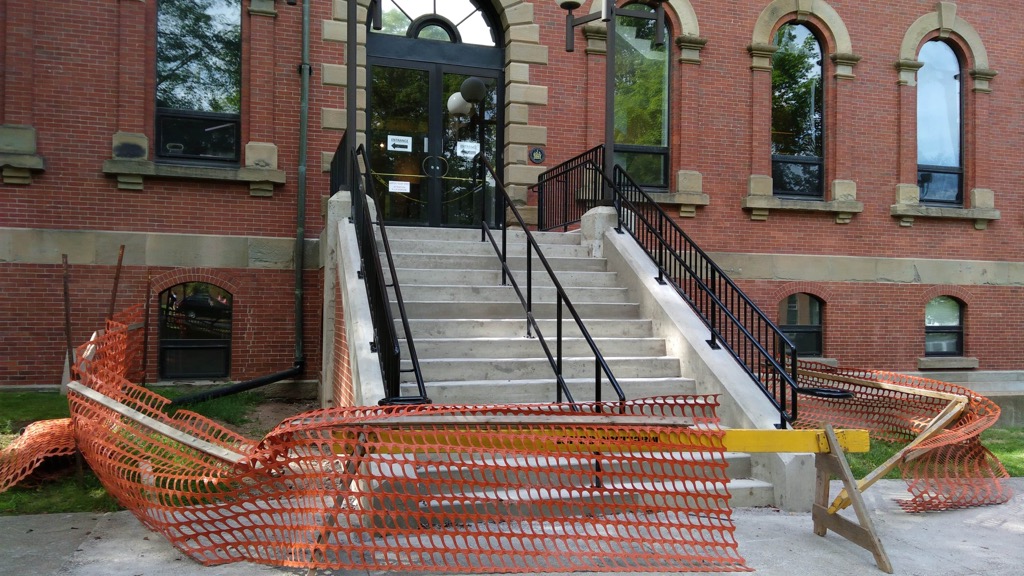
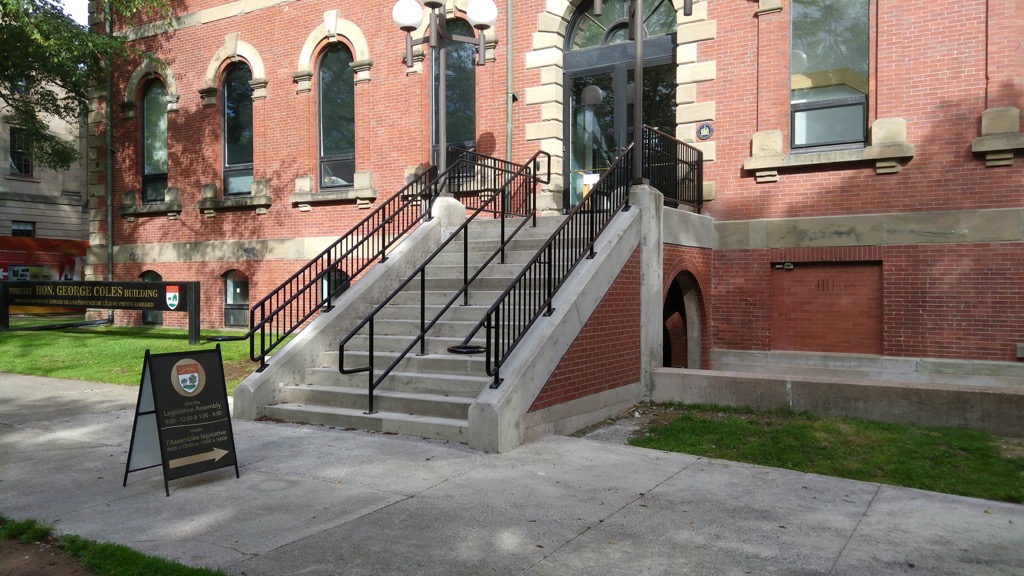
For what seems to be the first time in my lifetime, Triscuit cracker boxes have undergone a redesign. I like it.
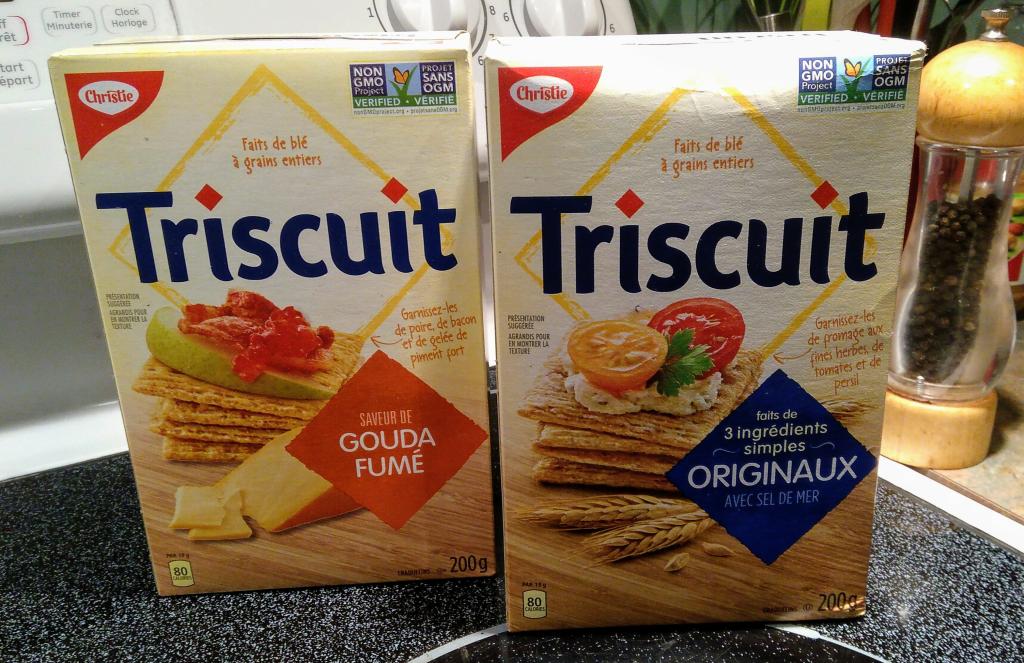
From What If Stores Charged Admission? in The Business of Fashion:
Ah, but there is at least one café that recognises that customers truly value the time spend in their establishment. Its a small chain in the United Kingdom called Ziferblat Café (ziferblat being the Russian word for “wall clock”). Here, you sign in when you enter and pay six pence per minute for the time you spend there — and the coffee is free! Sure, you’re not going to get a tall, half-sweet caramel macchiato (or whatever your favorite drink is), but you are going to get a place to call your own for however long you want to stay, with books, magazines and newspapers, free internet and some rather sociable people to chat with, if you so choose.
This is an intriguing mashup of the private club, the co-working space, pay-as-you-go mobile plans and the local coffee shop. From the café’s website:
Ziferblat has a relaxing sitting room, shared office space, private meeting rooms and a full programme of events - it is place where you can do as you please, like an extension of your own home.
Work, Study, Relax, Play, Attend and Put on Events, eat cake, have a brew or breakfast or afternoon tea or…..
You will be welcomed by a Ziferblat host and can help to create and develop the concept by putting on events, volunteering or joining our team!
We have amazing wi-fi, newspapers, board games, a piano and record player, 43 kinds of tea, our own special Ziferblend coffee, we are very children friendly and dog friendly, too!
Part of what makes us unique is that everything you receive is free, the coffee, the cake, the wi-fi, everything, you pay only for the time you spend at just 8p a minute. If you want to spend the day with us, your spend will be capped at 4 hours and the rest of your time is free! That includes Vat and we don’t charge for service or, in fact, anything else at all.
My local coffee shop, Receiver Coffee, has a capacity issue that renders it delightful at 7:30 a.m. and less hospitable, because of tourists and “cheap place to work all day” laptop-bearers, for much of the balance of the morning and afternoon; is a by-the-minute charge the solution to this?
8p is 13 cents Canadian a minute, or about $8 an hour; that seems like a reasonable price to pay for a chair, table, coffee and cake. And yet it also offends my egalitarian sensibilities in the same way that having a private park would (I’d love a private park; I’m also offended by the very notion of a private park).
The Small Print Board Game Café has a scheme that’s similar in some ways to Ziferblat:
Here’s the scoop: You pay $5 and you can play as many board games as you want and stay as long as you want. With over 300 games to choose from; these range from classics like Monopoly, Pictionary and Scrabble to more modern games such as, Ticket to Ride, Settlers of Catan and Carcasonne. There will be staff that have intimate knowledge on board games, who can help you select a game and set it up providing you with a walk through of the game and its rules; let us take care of the small print!
I’ve never been to Small Print because the conditions of its liquor license don’t allow [[Oliver]], being under 19, to be there after 8:00 p.m., and if I was going to go somewhere and play board games with someone, it would be with Oliver, after 8:00 p.m. But I’m not offended by the cover charge, and that it’s still in place, a year after opening, suggests that it’s working for them.
The other Prince Edward Island experiment in this regard has been Avonlea Village in Cavendish, for which, in a quirk of history, I wrote the original business plan. When Avonlea opened there was a modest admission charge that some, especially Islanders, resisted as, in essence, “paying for the right to shop.” As Avonlea evolved, the commercial aspects of the attraction gave way to Anne of Green Gables-related activities and theatre and, with this change, the admission fee rose; more recently the model changed again, with the admission fee removed entirely and Avonlea refocusing on the commercial, especially its cluster of restaurants.
Would you pay $8 an hour for a clean well-lighted place to drink coffee and read the newspaper?
Eight years ago, circumstances conspired to see me join the gym at the University of PEI. My aerobic activity of choice there was the stationary bicycle, and a fleet of these was position to overlook the CARI pool next door.
Because I arranged my trips to the gym to coincide with my Philosophy 105 classes, I was there at the same time every day, and, as it happened, this also coincided with an acquafit class in the pool that I overlooked as I cycled; it was led by a determinedly enthusiastic woman who impressed me with the degree to which she was able to motivate those in her charge.
Even earlier in my time on Prince Edward Island, I made the acquaintance of Dave Cairns. Dave was the deputy to Director of Computer Services Jim Hancock when I first met him, and when Jim retired Dave became the director himself. Our paths crossed many times over the years, officially and otherwise; among other things I credit Dave with inculcating my attitude toward backing up computers (to paraphrase Dave: “it’s not if your disk will fail, it’s when”), an attitude that’s served me very well.
Some years ago Dave moved from leading Computer Services at the university to a more over-arching technology-architecting position and then, a few years after that, and much earlier than I would have expected, he retired from the university completely. I didn’t know Dave well-enough at the time to ask why, but others suggested that his wife was ill, and he was taking the time to help support her.
When my partner [[Catherine]] was diagnosed with metastatic breast cancer in the fall of 2014, these two seemingly separate threads of my life–the enthusiastic woman in the pool, my friend Dave the technologist–merged, as I came to realize that the woman in the pool was Marlene, Dave’s wife, and that Marlene too was living with metastatic breast cancer; indeed she’d been living with it back in 2009 when I saw her in the pool, and she was living with it still.
In the years since, both Marlene and Dave became valued supporters of Catherine and I.
Marlene was, as Catherine put it, “the really hopeful one” in her metastatic breast cancer support group; Dave, both face to face and over the wire, has been able to give me the benefit of his experience, small-scale and large, with cancer and treatment and how to be an effective supporter. Although their practical and emotional support has been enormously helpful to both Catherine and to me, it was perhaps their example of living with cancer, hopefully and undefeatedly (if that’s a word) for so long that was most helpful.
Marlene died on Monday.
A member of the cancer support group generously sent us an email to let us know, in case we were distracted by other things.
It was difficult news to learn: we both lost a trusted friend and supporter, yes; but we also knew, more intimately than most, the challenges of living with cancer, and how wrenching Marlene’s death must be for Dave and for their daughters.
I went to the wake yesterday, and as I stood in the line with Marlene and Dave’s friends and coworkers and neighbours, and watched a slide show of Marlene and Dave’s family life playing in the lobby, Marlene suddenly grew from being “that energetic woman in the pool” and “Dave’s wife” and “a member of Catherine’s support group” to become a fully-formed human being. With Christmas mornings and birthday cakes and climbed mountains and hospital beds and newborn children and quiet moments by the fire and high school graduations.
I have a modest little newsletter that I send out to Catherine’s friends and family to update them on her condition; Marlene was on that list, and often replied to my messages with words of encouragement or advice. My last email from her was only last week:
Yeah some good news, go Team Catherine! Keep going and make sure she keeps the chemo room filled with laughter! Best medicine of all, LOL
How are you doing??
It is unimaginably sad to realize that the vital person behind those words will email no more. And yet also hopeful to know that someone who lived so long-buffeted by cancer could continue to muster such hope and enthusiasm.
Another of Marlene’s support group wrote me yesterday: “that is the legacy of this disease – lives half lived.”
As I sat in the chapel this afternoon for Marlene’s funeral service, and heard her brother describe her life and that of her family, it became apparent that, even though this was as true for her as for anyone, she managed to squeeze a lot into that “half-lived” life.
In that, she leaves us all a great gift, and an enduring buttress against the winds we’ll face ahead.
Thank you, woman in the pool; you helped.
I subscribe to the Charlottetown Airport email newsletter. There’s a lot of “air travel is awesome” marketing therein, but there’s compelling information too; yesterday’s newsletter provided the “seats per day” figures for the fall flight schedule (September 6 – October 28, 2017):
| AIRLINE | MARKET | FLIGHTS/DAY | SEATS/DAY |
|---|---|---|---|
| Air Canada | Toronto | 2 | 336-400 |
| Air Canada | Ottawa | 1 | 50 |
| Air Canada | Montreal | 2 | 214 |
| Air Canada | Halifax | 4* | 72 |
| WestJet | Toronto | 1 | 134-168 |
It’s interesting to see the airport’s capacity expressed this way: boiled down, it means that there’s space for 904 people to leave the Island by air every day. This means that if everyone had to leave the Island for some reason, using only scheduled flights, it would take 161 days.
I called the airport to ask about the “fall flight schedule” because I was intrigued that there seemed to be coordination here between WestJet and Air Canada, and I wondered whether there’s some sort of international “flight season” calendar. What I learned is that there is a standard seasonal schedule internationally, but it’s limited to two seasons, winter and summer; here on PEI, because there’s such a marked change between summer tourist traffic and the rest of the year, the airport has a sort of “season within a season” that they call the “fall season,” and that’s what runs from September 6 to October 28, with the winter season starting on October 29.
Because airlines operate as a sort of quasi-interconnected global network, it makes sense that there would be some sort of changeover date, to allow better coordination of airport slots and airline interconnection. The standards behind this are coordinated by the International Airline Transport Association, and are published in its Worldwide Slot Guidelines publication. In there you’ll find the definition of the flight seasons:
Season: the summer season commencing on the last Sunday in March, or the winter season commencing on the last Sunday in October.
This is done under the rubric of “slot guidelines” because, for airlines and airports, that’s the most important thing about a schedule: there needs to be a place to load and unload a plane at the departure and destination airports. The IATA defines a “slot” as:
Slot: a permission given by a coordinator for a planned operation to use the full range of airport infrastructure necessary to arrive or depart at a Level 3 airport on a specific date and time.
The international “slot coordination” process doesn’t include Charlottetown Airport, it seems, because we have a “Level 1” airport, where “an airport where the capacities of all infrastructure at the airport are generally adequate to meet the demands of users at all times.” In other words, things aren’t tight enough here that we need to conference about it.
In Canada the only “Level 3” airports, according to this IATA spreadsheet, are Toronto and Vancouver; Calgary, Montreal and Quebec are “Level 2.” Everything else is a “Level 1.”
The Winter 2017 flight season (known in the trade as W17/18) starts October 29, 2017 and ends on March 24, 2018; the Summer 2018 season (S18) starts on March 25, 2018. Airlines start coordinating for Summer 2018 next month.
North by Northwest is one of my favourite films of all time, and tonight I get to share it with Oliver, as it’s showing, for one night only, at the Cineplex.
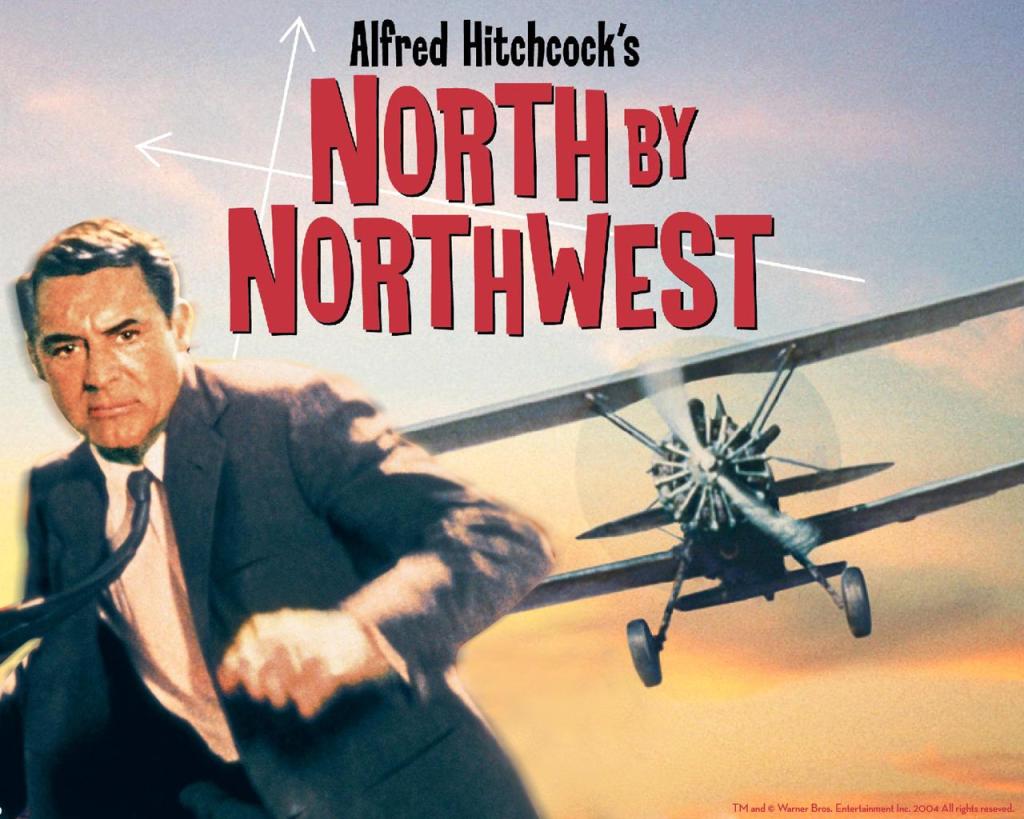
I purchased my first fountain pen in May of 2000 from Fountain Pen Hospital in New York City, a Waterman Hémisphère.
My first use of the pen was to write a letter to the editor of Saturday Night magazine. They didn’t run the letter, but they did run the envelope.
In the years since, my tastes have run to the cheaper end of the fountain pen universe, and I am especially fond of those made by Lamy; I own three of them, and I don’t believe I paid more than $30 for any of them.
I’ve always used cartridges in my fountain pens, mostly for fear of ink spills (as [[Catherine]] will attest, fear-of-spills runs strong in me). Many years ago my friend Catherine Hennessey generously gave me a bottle of Quink (which might be the most elegantly-named product ever). I was terrified of spilling the bottle, and I handled it like one might handle an atomic bomb. This fear prevented me from ever actually using the ink, and, as far as I know, it still languishes in some spill-proof corner of our attic.
All the talk of the joys of using dip pens when sketching, though, got me thinking that it might be time to break out of my ink shell, and that The Bookmark, our independent bookstore here in Charlottetown, has developed a helpful sideline in pens and inks and related supplies proved to be all that was needed to push me all they way.
Oliver and I took a walk up last night after supper and picked up a “converter” for my yellow Lamy Safari pen, along with a bottle of waterproof Noodler’s Ink (a laudable brand, but one with packaging seemingly designed on a Commodore 64 by someone who’s just figured out that you can stretch letters).
This morning at the office, I flushed the blue cartridge ink out of the pen, using this helpful video and a newly-acquired nose-aspirator-bulb, and then carefully dipped the converter into the ink bottle and used its twisting suction mechanism to slurp up some ink.
I pulled a Fabriano notebook from the reserve shelf, and took the newly-equipped pen for a ride:
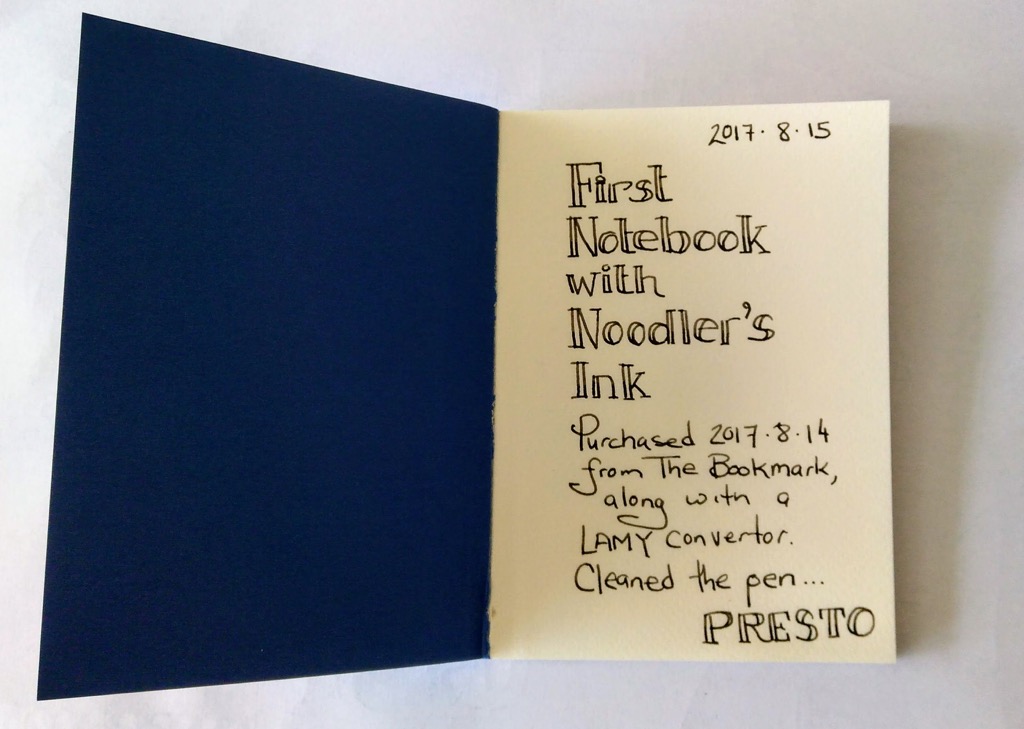
The ink is beautiful, especially on the Fabriano paper. And it is, indeed, waterproof:
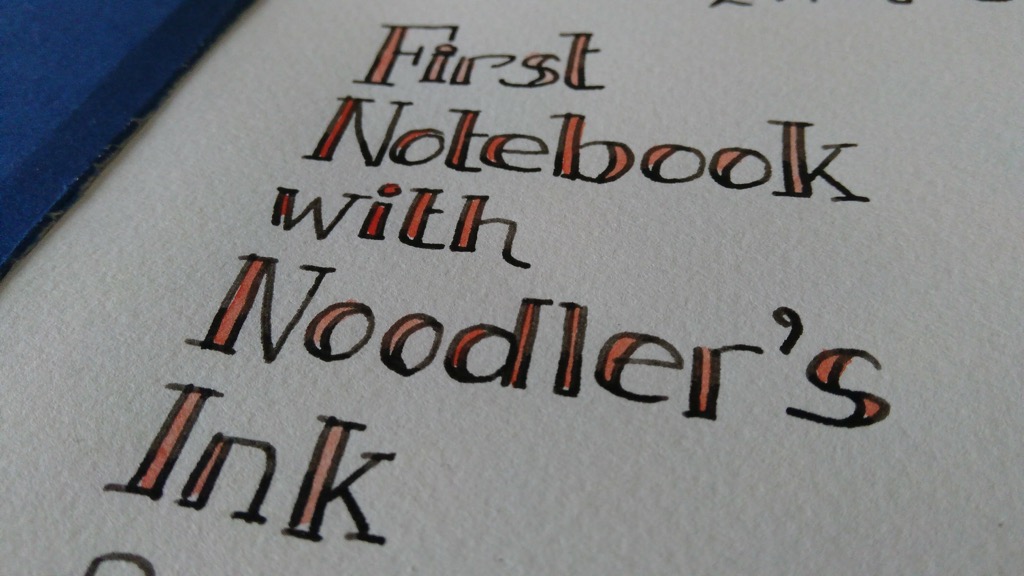
And now I’ve got no more cartridge-anxiety and can write and sketch with carefree abandon.
I’ve been coming to Hon. David MacDonald’s breakfast seminar all summer long. So far the “breakfast” has consisted solely of high-fructose-corn-syrup-based Chartwells fare.
Until this morning.
When one of our number brought a loaf of bread he baked this morning. Which means that while I got up at 7:00 a.m., he got up at 5:00 a.m.
So, apparently, it takes 8 weeks to achieve sentience as a group.
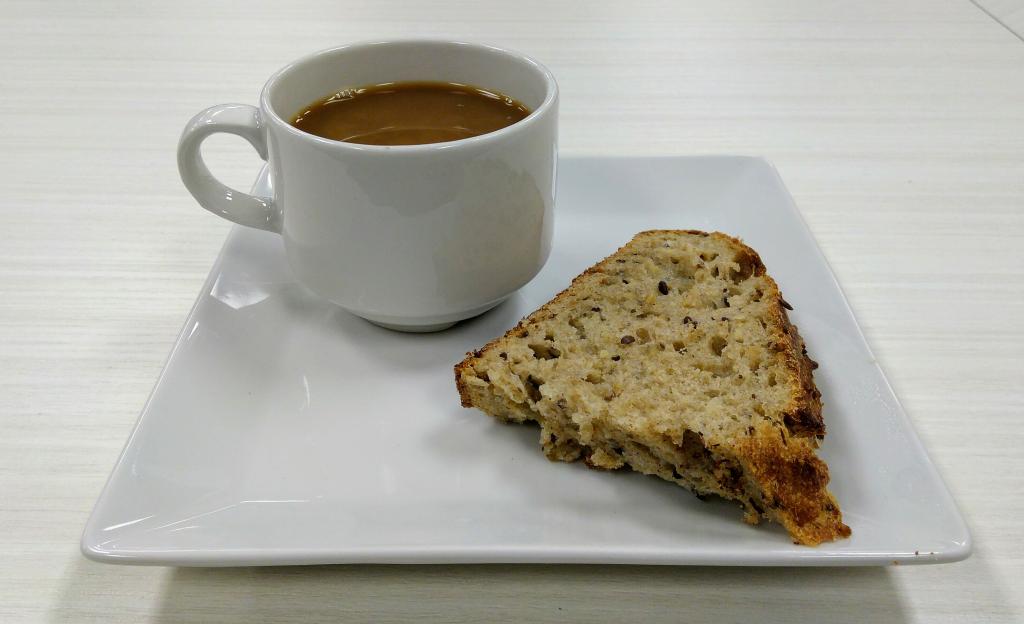
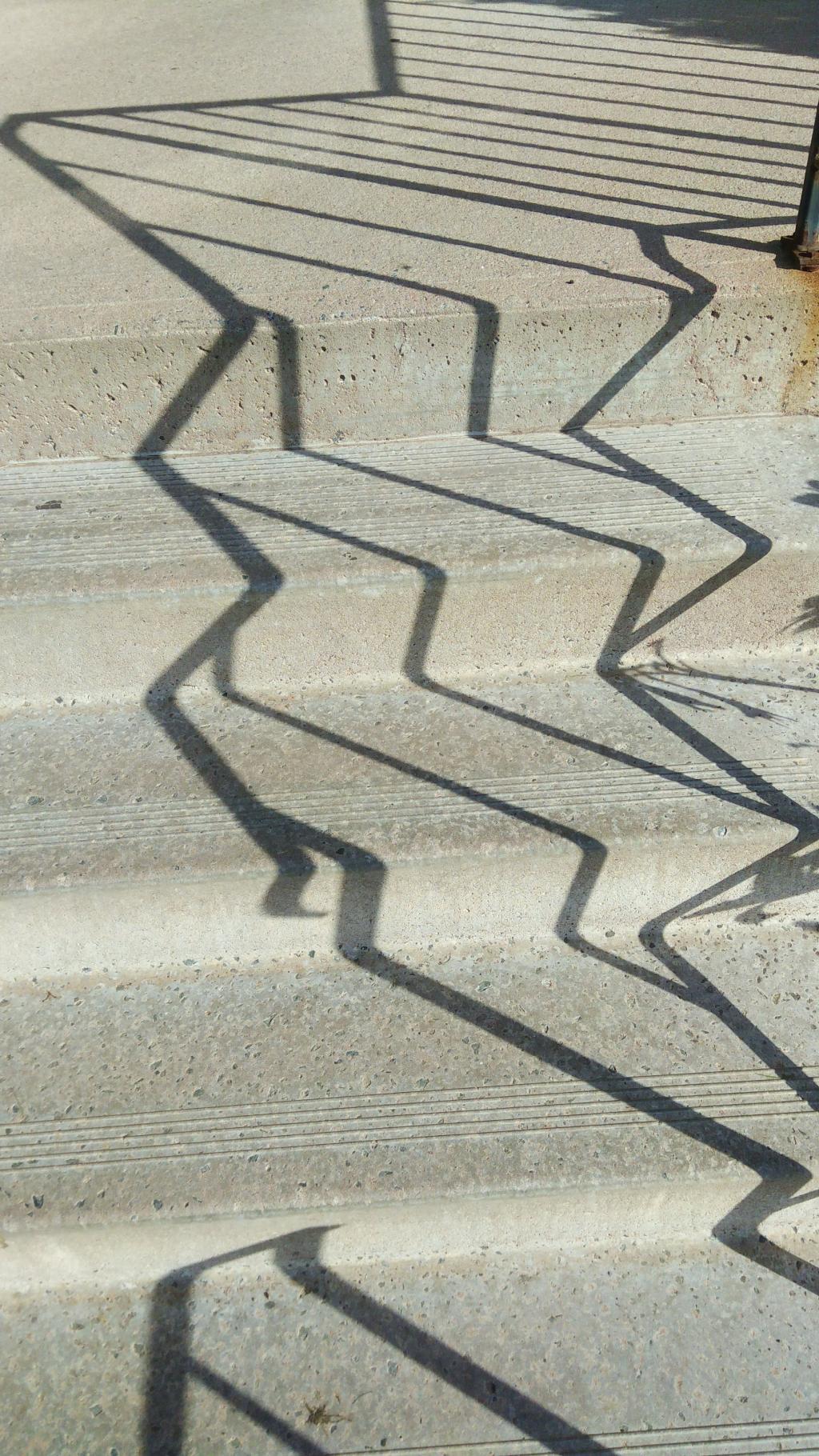
 I am
I am